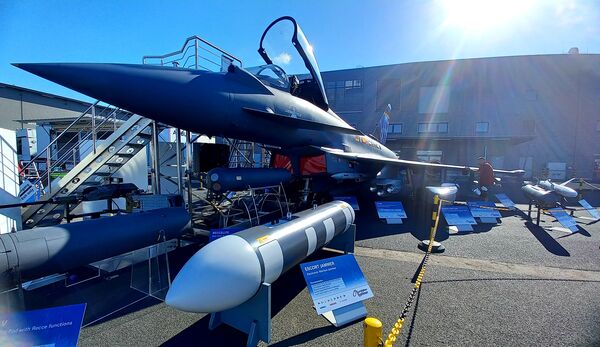
A full-scale mock-up of the Eurofighter EK (formerly ECR) was displayed at ILA 2022, complete with an electronic attack pod in the foreground. (Janes/Gareth Jennings)
The Luftwaffe's commitment to field an airborne electronic attack (AEA) capability for NATO has slipped by at least three years, with an overdue formal requirement expected to be launched by the Bundeswehr in the coming months.
Industry officials told Janes at the ILA Berlin Air Show on 22 June that the previously stated timeline of 2025 for fielding the Luftgestützte Wirkung im Elektromagnetischen Spektrum (luWES) mission for NATO has slipped to 2028, with the German Ministry of Defence (MoD) expected to launch a market survey in support of the capability before the end of 2022.
“The Luftwaffe wants a Eurofighter EK [Elektronischer Kampf (Electronic Combat)] solution in 2028,” Ralph Schnell, sales manager, Electronic Warfare Strategic Campaigns at Hensoldt said. “There will be a market study first in 2022 to see what might work, and we would then expect an RFI [request for information] or RFQ [request for quotations] in 2023 and a contract no later than 2024.” This timeline was repeated by Raffael Klaschka, business director, Aerospace Campaigns at rival bidder Elektroniksystem und Logistik (ESG), who noted to Janes , “The Luftwaffe wants a militarily proven and off-the-shelf solution by 2028.”
Although no official reason for the luWES delay from 2025 to 2028 has been given, it likely stems from the German government's decision to switch from acquiring the Boeing EA-18G Growler for the mission to instead developing the Eurofighter EK (previously known as the Eurofighter Electronic Combat Role [ECR]), the announcement for which was made in March.
Looking to read the full article?
Gain unlimited access to Janes news and more...







